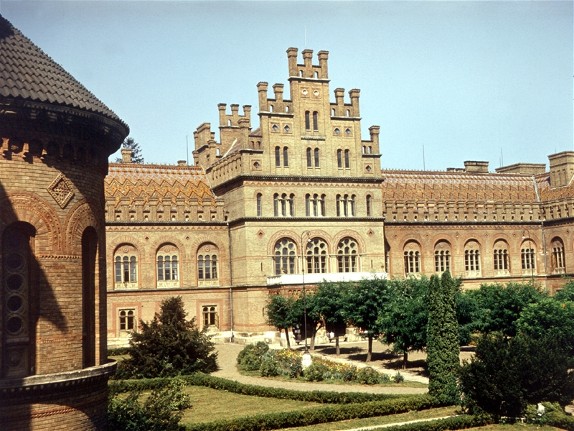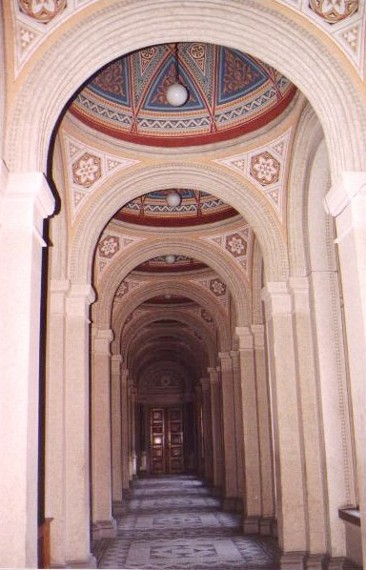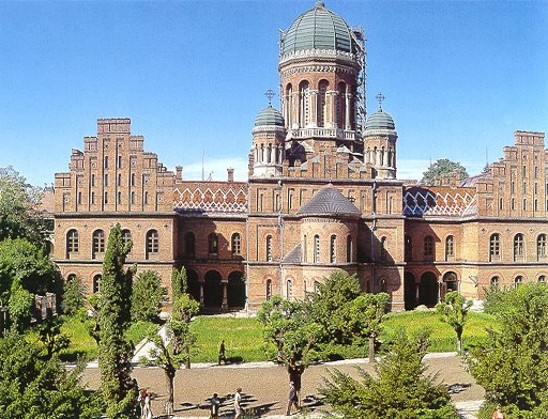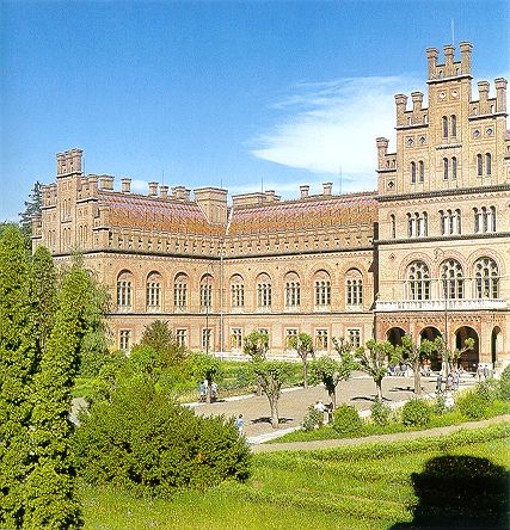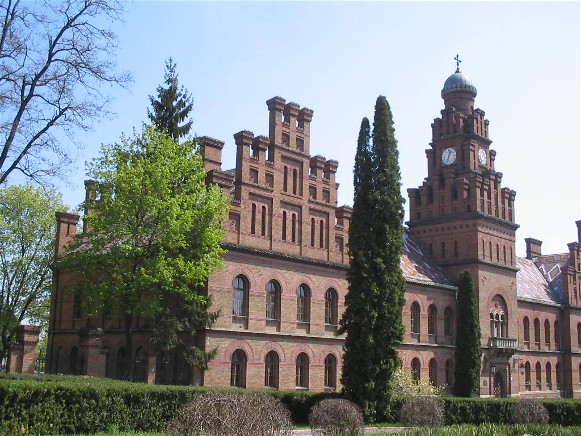Chernivtsi National University
Chernivtsi National University (Чернівецький національний уніерситет імені Юрія Федьковича; Chernivetskyi natsionalnyi universytet imeni Iuriia Fedkovycha). An institution of higher learning in Chernivtsi; one of the oldest universities in Ukraine. The university was founded in 1875, succeeding the Chernivtsi Higher Theological School, which had existed since 1827. Until 1918 it was known as Franz-Josefs Universität, with German as the language of instruction and with separate departments of the Ukrainian language and literature and Romanian language and literature. At that time, it was the easternmost German-language university in Europe (especially after the German-language Dorpat University in present-day Estonia was fully Russified between 1882 and 1893). From 1919 to 1940 the university was called the Universitatea Regele Carol I din Cernăuţi, with instruction in Romanian. In 1944 the Soviet authorities reorganized the university as Chernivtsi State University with Ukrainian as a language of instruction. In 2000 the university was granted a national institution of higher learning status and assumed its present name.
An idea to open a university in Chernivtsi was first broached in 1848 in the ‘Petition of the Province’ submitted by the deputies from Bukovyna to the Austrian government. At that time, however, the proposal was not approved. A successful proposal was put forward in 1872 by a deputy of the Bukovynian Diet and the Austrian parliament Kostiantyn Tomashchuk. He justified the need for a German-language university in the capital of Bukovyna by the Polonization of Lviv University and by remoteness of Austria’s German-language universities, which prevented the graduates of the German gymnasium in Chernivtsi from obtaining higher education in their native language. This proposal was approved and the university was opened in October 1875 on the premises of the local teachers' seminary, with Tomashchuk appointed its first rector. During the Austrian period the university had three faculties: Orthodox theology, law, and philosophy. The Ukrainian language and literature department was in the faculty of philosophy and was chaired by Klymentii Hankevych and Omelian Kaluzhniatsky (1875–6), Hnat Onyshkevych (1877–82), and Stepan Smal-Stotsky (1885–1918). The department of Slavic languages was headed by O. Kaluzhniatsky (1875–99) and Yevhen Kozak (1899–1923). The department of practical theology was under the direction of Denys Yeremiichuk-Yeremiiv (1899–1919). A vast majority of faculty members were Germans. The university employed several world-class scholars, among them jurists Eugen Ehrlich and Hans Gross, political economist Joseph Schumpeter, historian Raimund Friedrich Kaindl, mathematician Leopold Gegenbauer, botanist Eduard Tangl, and chemist Richard Przibram.
In this period the university was attended not only by Bukovynians, but also by many students from Galicia, among whom were Ivan Franko, Les Martovych, and Denys Lukiianovych. Volodymyr Milkovych defended a doctoral thesis on the history of Eastern Europe and eventually was appointed professor at the university (1895–1919). Oleksander Kolessa received a doctorate in the Ukrainian language at Chernivtsi University. The following rectors of the university were Ukrainians: Kostiantyn Tomashchuk (1875–6), Omelian Kaluzhniatsky (1889–90), and Yevhen Kozak (1907–8). Ukrainian students constituted, on the average, about 20–25 percent of students enrolled: 41 out of a total of 208 in 1875, and 303 out of a total of 1,198 in 1914. There were about as many Romanians, with the majority of students being Jewish or German. Females were allowed to attend the university in 1879. Between 1875 and 1918 more than 4,000 students graduated from the university. While promoting the German language and culture in Bukovyna, the university also served a model of interethnic tolerance and cooperation.
In 1918–40 Chernivtsi University was Romanianized and named first after king Ferdinand I of Romania, later renamed after his uncle king Carol I (with the official name: Universitatea Regele Carol I din Cernăuţi). During this period the Ukrainian departments were dissolved, and the university’s Ukrainian professors were dismissed. The faculty of philosophy was split into the faculty of philosophy and literature and the faculty of natural science. For many years the university’s rector was I. Nistor, who was hostile towards Ukrainians. In 1920 there were 239 Ukrainians in a student body of 1,671. In 1933 the body of 3,247 students consisted of 2,117 Romanians, 679 Jews, 199 Germans, 155 Ukrainians, 57 Poles, and 40 of other nationalities. With the rise of a dictatorial trend in Romania in the late 1930s, all student societies at the university were dissolved with the exception of a single one that promoted the devotion to the king, monarchy, and the ‘Greater Romania.’
In 1940 northern Bukovyna was annexed to the Ukrainian Soviet Socialist Republic, and Ukrainian became the language of instruction at Chernivtsi University. Between 1941 and 1944 the university again functioned as a Romanian-language institution under Romanian occupation. In 1944 the Soviet authorities reorganized the university as Chernivtsi State University (ChDU) and by 1955 it consisted of 11 faculties: history, philosophy, foreign languages, geography, biology, chemistry, physics-mathematics, economy, technology, and correspondence education. This structure remained largely intact through the 1980s. The theology faculty was abolished. Evening-school, correspondence-school, and graduate-school programs were introduced. In 1982–3 there were close to 10,000 students enrolled at the university, 54 percent of whom were correspondence and evening students. The teaching faculty numbered about 500, including 26 full professors. Public efforts to rename the university in honor of Yurii Fedkovych, led by the literary scholar Yevhen Kyryliuk, did not gain the consent of the Soviet authorities until 1989. In the 1970s a faculty-and student-exchange program was established between Chernivtsi University and the University of Saskatchewan in Canada. In independent Ukraine the university has been among the leading higher educational institutions in the country, and particularly in western Ukraine. The university was granted the national university status in 2000 and assumed its current name: Chernivtsi National University (ChNU).
The university’s main building since 1955 has been the former residence of the Orthodox metropolitans of Bukovyna and Dalmatia. It has been a UNESCO World Heritage Site since 2011 (one of the seven such sites in Ukraine, but the only university building with this status). Currently, ChNU has 11 faculties (geography; economy; foreign languages; history, political science, and international relations; architecture, construction, and decorative and applied arts; pedagogy, psychology, and social work; mathematics and informatics; philology; finances, entrepreneurship, and accounting; physical culture and human health; and law) and 2 institutes (biology, chemistry and bioresources; and applied physics and computer sciences). The enrollment is above 14,000. There are a number of research institutions associated with the university: a botanical garden (est 1877), a biological research base in Zhuchka, a geophysical observatory, a physics laboratory for semiconductor and thermodynamic research, an experimental fish farm, seismological and meteorological stations, and four museums (of natural science, ethnography, geology, and the historical-architectural museum complex). ChNU also operates several international specialized centers, including Ramon Hnatyshyn Canadian Studies Centre, the Center for American Studies, the Center for Romanian Studies, the Gedankendach Center for German-Language Studies, the Center for Euro-Atlantic Integration and Security, the Center for Czech Studies, the Center for Slavic Studies, and others. ChNU’s scholarly library is one of the oldest and largest university libraries in Ukraine. It houses about 2.6 million books (2020), including 70,000 rare books and manuscripts (the earliest dating back to the fifteenth century). Among other highlights of the library is the collection of books granted by the Habsburg dynasty (the so-called ‘Habsburg Library,’ with more than 1,400 volumes) and the extensive collection of publications and manuscripts related to Bukovyna (‘Bukovinensia’). The university has published Naukovi zapysky (58 vols, 1945–67), monographs, textbooks, and many other works. ChNU’s chief academic periodical is Naukovyi visnyk published in several series, including history (52 vols, 1996–), biology (9 vols, 2009–), German philology (822 vols, 1996–), economy (830 vols, 1996–), geography (824 vols, 1996–), and chemistry (819 vols, 1996–). Other notable periodicals include Pytannia literaturoznavstva (102 vols, 1966–), Mediaforum (7 vols, 2011–), and Bukovyns'kyi matematychnyi zhurnal (8 vols, 2013–), previously published under the name of Naukovyi visnyk Chernivets'koho universytetu. Seriia matematyka (1999–2012).
Today ChNU is one of the most prestigious higher educational institutions in Ukraine and it has been consistently ranked among the nation’s best universities. For instance, in 2021 it was ranked 15th in the Consolidated Ranking of all Ukrainian institutions of higher learning (more than 240 featured) according to the influential educational web portal Osvita.ua. In the same ranking ChNU also appeared as the 9th best ‘classical university’ in Ukraine and the 4th best institution of higher learning in western Ukraine.
BIBLIOGRAPHY
Prokopowitsch, E. ‘Gründung, Entwicklung und Ende der Franz-Josefs Universitüat in Czernowitz,’ in Schriften zur Geschichte des Deutschtums in der Bukowina (Clausthal-Zellerfeld 1955)
Turczynski, E. ‘Die Universitüat Czernowitz,’ in Buchenland. Hundertfünfzig Jahre Deutschtum in der Bukowina (Munich 1961)
Systematychnyi pokazhchyk do vydan' Chernivets'koho derzhavnoho universytetu (1948-cherven' 1965) (Chernivtsi 1965)
Alma Mater Francisco Josephina. Die deutschsprachige Nationalitüaten-Universitüat in Czernowitz (Munich 1975)
Kobylians’kyi, I. Chernivets'kyi universytet (Uzhhorod 1975)
Abramovych, N. et al (ed). Chernivets'kyi universytet, 1875–1995: Storinky istoriï (Chernivtsi 1995)
Chernivets'kyi natsional'nyi universytet imeni Iuriia Fed'kovycha (Kyiv 2005)
Serhiy Bilenky, Arkadii Zhukovsky
[This article was updated in 2021.]
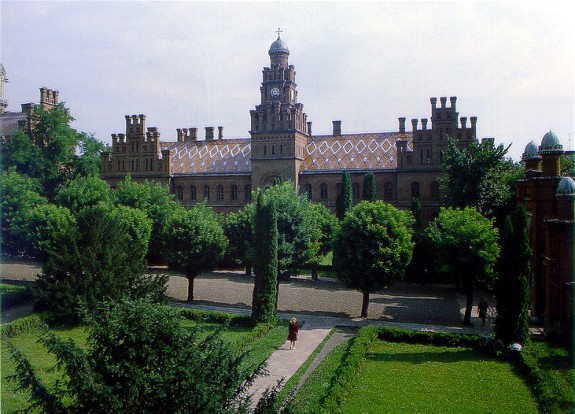
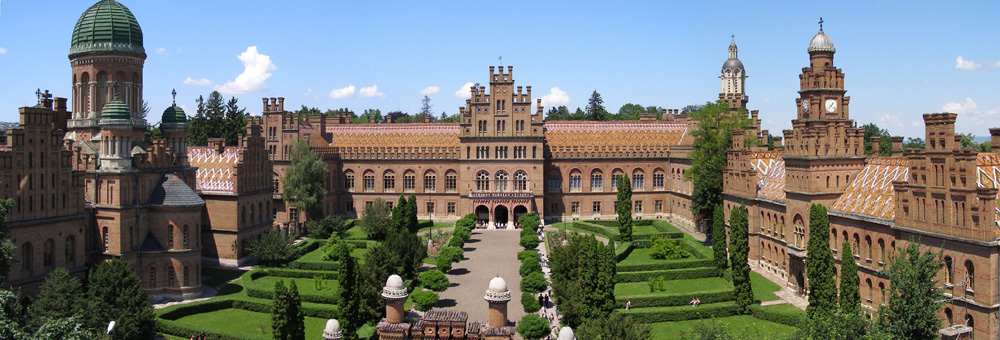
.jpg)
